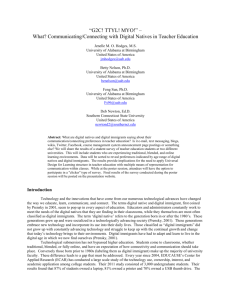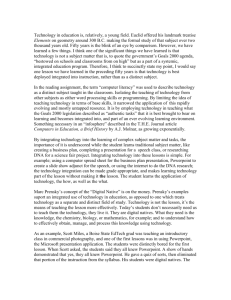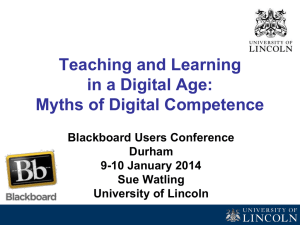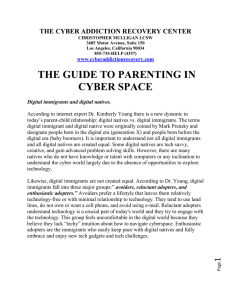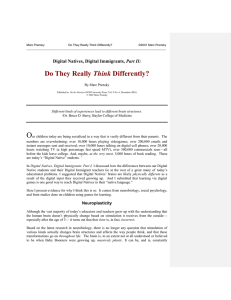Digital Natives - UCF College of Education and Human Performance
advertisement
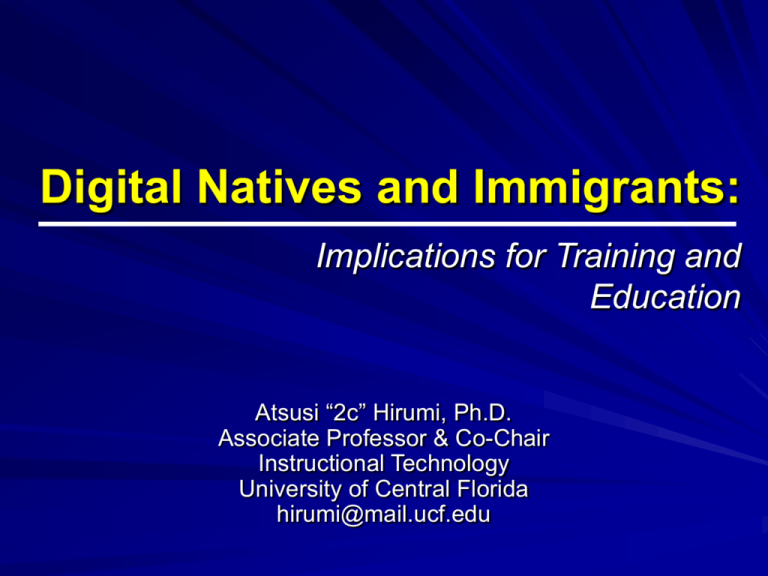
Digital Natives and Immigrants: Implications for Training and Education Atsusi “2c” Hirumi, Ph.D. Associate Professor & Co-Chair Instructional Technology University of Central Florida hirumi@mail.ucf.edu Basic Premise Today’s schools and training programs are not designed for today’s youth. Today’s Youth First generations to grow up in Digital Age (Digital Natives). Surrounded by computers, videogames, digital music players, video cams, cell phones, Internet, instant messaging, email, etc. Average college graduates < 5,000 hours reading > 200,000 emails and instant messages > 10,000 hours playing video games > 10,000 talking on cell phones > 20,000 hours watching TV Today’s Youth Children raised with the computer “think differently from the rest of us. They develop hypertext minds. They leap around. It’s as though their cognitive structures were parallel, not sequential.” (Winn, 1997) “Linear thought processes that dominate educational systems now can actually retard learning for brains developed through game and Web-surfing processes on the computer.” (Moore, 1997) Today’s Youth Neurobiology Brain structure and organization changes throughout life. Brain cells replenished constantly. Thinking patterns change depending on experiences. Today’s Youth Neurobiology Emotion stimulates amygdala that codes information differently. Stories stimulate both left & right hemispheres of brain; facts stimulate only the left. What’s the Problem? With insufficient time, training, tools or incentives, educators rely on past practices. Training and education predominately teacher-directed Many online courses continue to mimic [poor] correspondence mail models of DE. What’s the Problem? Teacher-directed methods and materials…. • Rely heavily on text-based materials that focus on the transmission of information • Limited interactions resulting in feelings of isolation & anonymity • Do not promote social interactions to interpret & construct knowledge • Are not engaging (w/o teacher) • Fail to use the potential of technology What’s the Problem? “What is in the (text) book is only one fourth of the story. It is like an iceberg where threequarters of the story you don’t see, it is beyond the page.” Hemingway Purpose Compare & Contrast Digital Natives & Digital Immigrants Describe Planned R&D Efforts Discuss Implications for Training & Education Compare & Contrast Compare & Contrast Digital Immigrants Step-by-Step Linear Processing Text First Work Oriented Stand Alone Digital Natives Random Access Parallel Processing Graphics First Play Oriented Connected Planned R&D Efforts Develop instrument distinguishing Digital Natives and Immigrants (Kelsey) Test Prensky’s propositions (Jeonghee, Kelsey) Taxonomy for analyzing game design (Angelique) Review game engines (Pete) Integrating ISD “hooks” into Delta 3D Engine (Patty) Develop EME6XXX Instructional Game Design for Training and Education (Kelsey, Pete, Rodney) Storytelling and Gaming Research Support Site Testing Prensky’s Propositions Natives Performance Immigrants A B A Text-First B Graphics-First Testing Prensky’s Propositions Natives Performance Immigrants A B A Text-First B Graphics-First Testing Prensky’s Propositions O1 O1 RN RI X1 X1 O2 O2 O3 O3 O1 O1 RN RI X2 X2 O2 O2 O3 O3 Research Design for ATI Study Testing Prensky’s Propositions R X1 O2 O3 R X2 O2 O3 O1 X1 O2 O3 X2 O4 O5 Basic Research Designs Discuss Implications Digital Immigrants Step-by-Step Linear Processing Text First Work Oriented Stand Alone Digital Natives Random Access Parallel Processing Graphics First Play Oriented Connected
